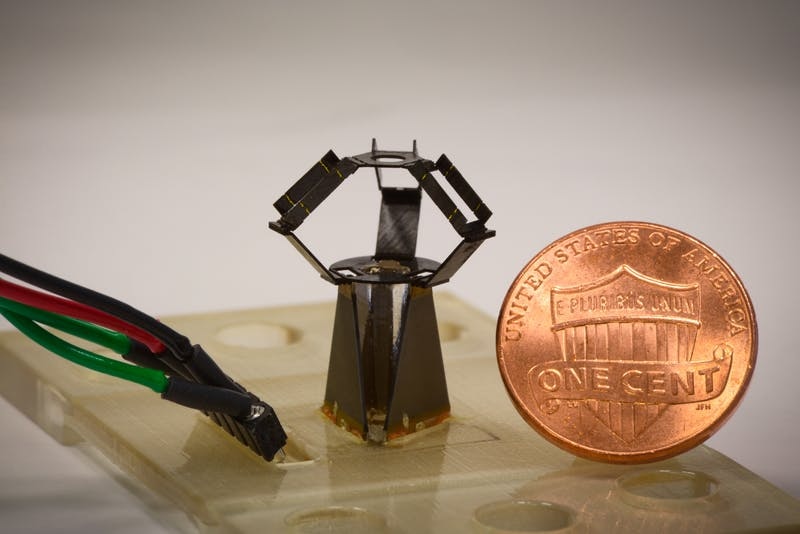Jan 18 2018
Delta robots are preferred for use in various industrial processes - such as welding, pick-and-place assemblies, food packaging, and machining - due to their greater accuracy and speed.
From the first model designed by Reymond Clavel for a chocolate factory to rapidly position chocolate pralines into their packages, Delta robots include three independently regulated and lightweight arms that direct a platform to move at high speed and precisely in three directions. The platform is either used as a stage, identical to those used in flight simulators, or linked with a manipulating device that can, for instance, get hold of, move, and set free objects in prescribed patterns. Over the years, roboticists have developed smaller Delta robots for performing functions in limited workspaces. However, attempts to further reduce their size to the millimeter level by adopting traditional production methods and components have been futile.
 Completely unfolded, the milliDelta is 15 mm-by-15 mm-20 mm and roughly compares to a cent piece. It uses piezoelectric actuators and flexural joints in its three arms to control high-frequency movements of a stage on top. (Image credit: Wyss Institute at Harvard University)
Completely unfolded, the milliDelta is 15 mm-by-15 mm-20 mm and roughly compares to a cent piece. It uses piezoelectric actuators and flexural joints in its three arms to control high-frequency movements of a stage on top. (Image credit: Wyss Institute at Harvard University)
An innovative design, the milliDelta robot, created by Robert Wood’s group at Harvard’s Wyss Institute for Biologically Inspired Engineering and John A. Paulson School of Engineering and Applied Sciences (SEAS) solves this difficulty in miniaturization, and has been described in the Science Robotics journal. The milliDelta has the ability to combine their microfabrication method with high-performance composite materials that can include bending actuators and flexural joints to function at higher force, speed, and micrometer precision, which render it adaptable to a wide array of micromanipulation functions in the fields of medicine and manufacturing.
In the year 2011, Wood’s team was inspired by origami and pop-up books, which led them to create a micro-fabrication strategy that allows the use of flat sheets of composite materials to assemble robots. Manufacturing of pop-up “microelectromechanical systems,” or MEMS, has since been adopted for designing dynamic centimeter-scale machines that just walk away, or can fly, similar to RoboBee. As part of their new research, the team put their strategy to create a Delta robot with the dimensions of just 15 mm by 15 mm by 20 mm.
“The physics of scaling told us that bringing down the size of Delta robots would increase their speed and acceleration, and pop-up MEMS manufacturing with its ability to use any material or combination of materials seemed an ideal way to attack this problem,” stated Wood, a Core Faculty member at the Wyss Institute and co-leader of its Bioinspired Robotics platform. Wood is also the Charles River Professor of Engineering and Applied Sciences at SEAS. “This approach also allowed us to rapidly go through a number of iterations that led us to the final milliDelta.”
The design of the milliDelta has a composite laminate structure including embedded flexural joints approximating the highly complex joints seen in large-scale Delta robots. “With the help of an assembly jig, this laminate can be precisely folded into a millimeter-scale Delta robot. The milliDelta also utilizes piezoelectric actuators, which allow it to perform movements at frequencies 15 to 20 times higher than those of other currently available Delta robots,” stated Hayley McClintock, first-author of the study, who is a Wyss Institute Staff Researcher on Wood’s team.
Moreover, the researchers showed that the milliDelta can function in a workspace of nearly 7 mm3 and that it can exert forces and display trajectories that—in addition to its high frequencies—can render it optimal for micromanipulations in industrial pick-and-place procedures and microscopic surgeries, for instance, retinal microsurgeries, performed on humans.
The team investigated the ability of the milliDelta to perform microsurgeries and other micromanipulations and found their robot to be a hand tremor-cancelling device. “We first mapped the paths that the tip of a toothpick circumscribed when held by an individual, computed those, and fed them into the milliDelta robot, which was able to match and cancel them out,” stated Fatma Zeynep Temel, PhD, co-first author of the study, who is a SEAS Postdoctoral Fellow in Wood’s team. The team considers that specialized milliDelta robots can be integrated into prevalent robotic devices, or they can be designed as standalone devices like, for instance, platforms for manipulating cells in research and clinical laboratories.
“The work by Wood’s team demonstrating the enhanced speed and control of their milliDelta robot at the millimeter scale opens entirely new avenues of development for industrial and medical robots, which are currently beyond the reach of existing technologies. It’s yet another example of how our Bioinspired Robotics platform is leading the way into the future,” stated Donald Ingber, MD, PhD, Wyss Institute Founding Director, who is also the Judah Folkman Professor of Vascular Biology at HMS and the Vascular Biology Program at Boston Children’s Hospital, as well as Professor of Bioengineering at SEAS.
Neel Doshi, a SEAS Graduate Student, and Je-sung Koh, PhD, a former Postdoctoral Fellow on Wood’s Wyss Institute/SEAS team, who is at present Assistant Professor at Ajou University in Korea, are the other authors of the research. Harvard’s Wyss Institute for Biologically Inspired Engineering and a National Defense Science and Engineering Graduate Fellowship funded the study.